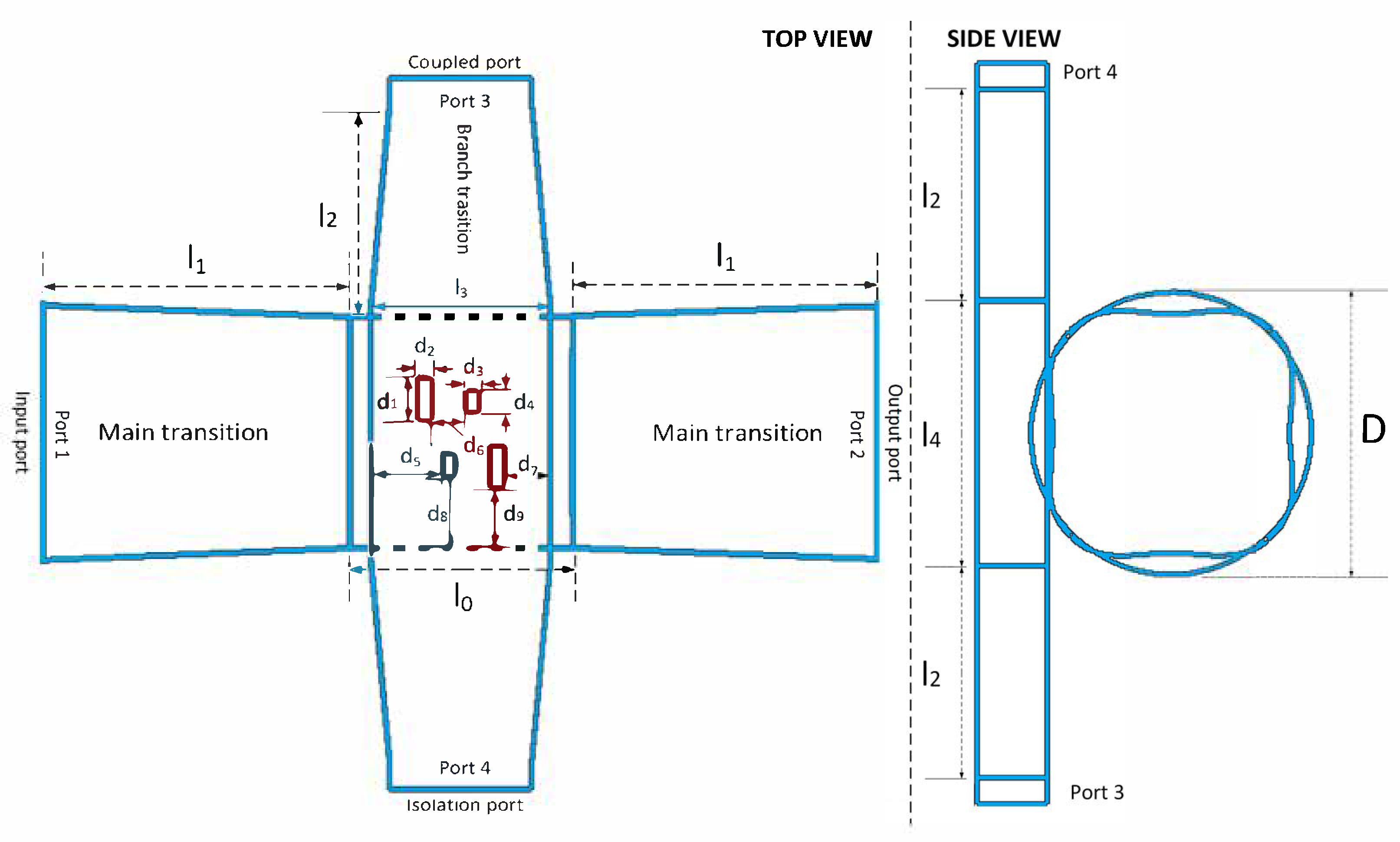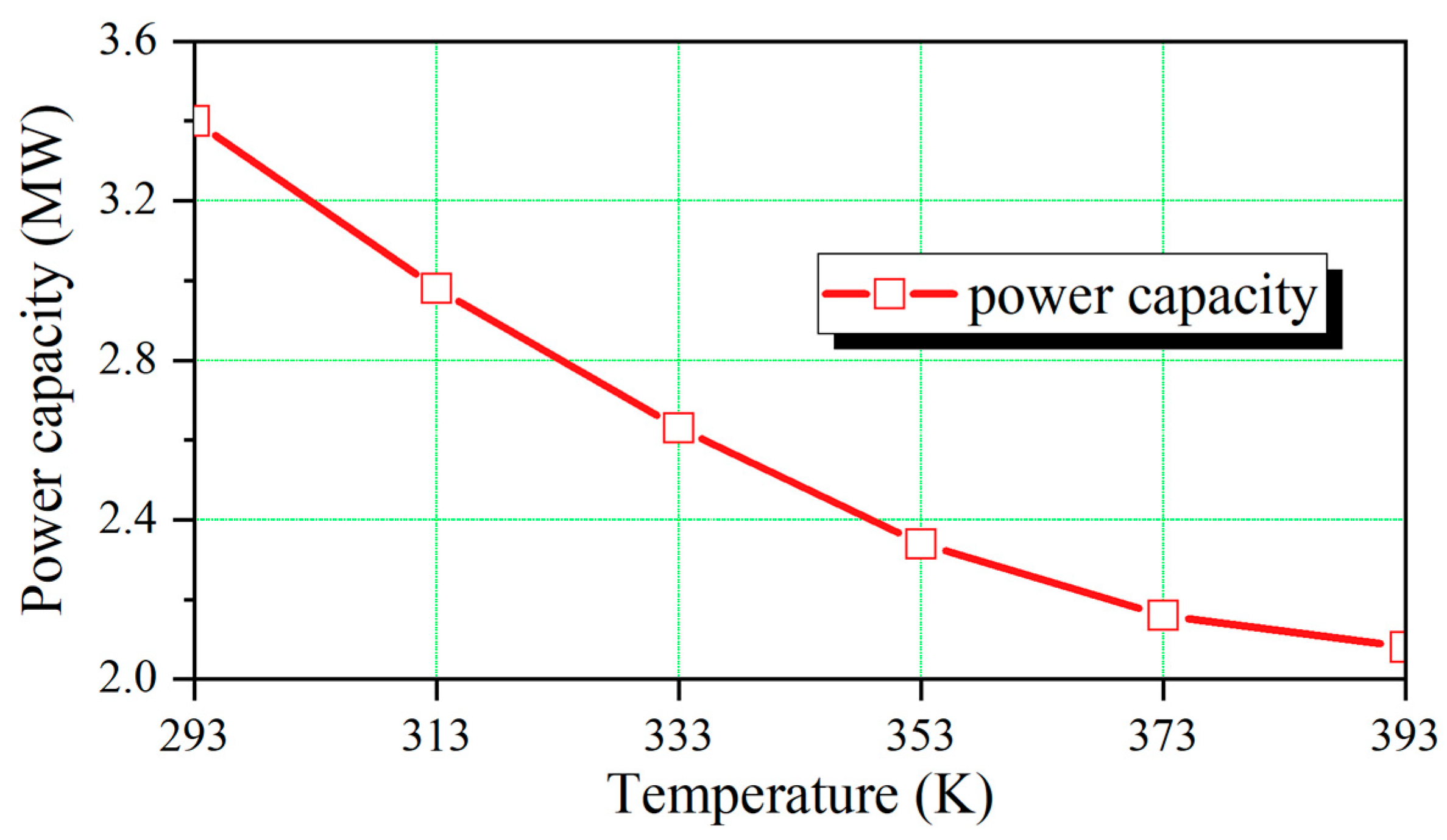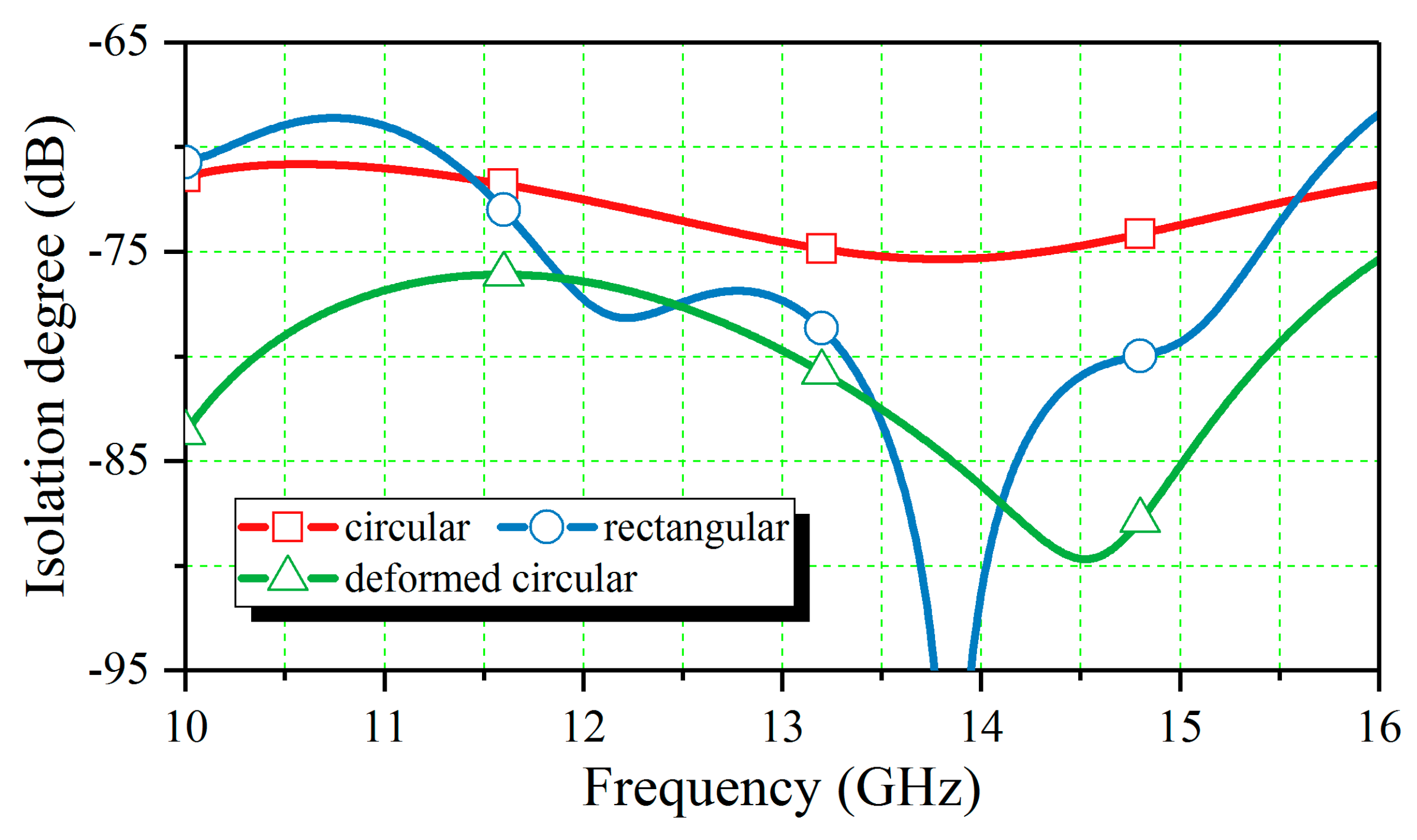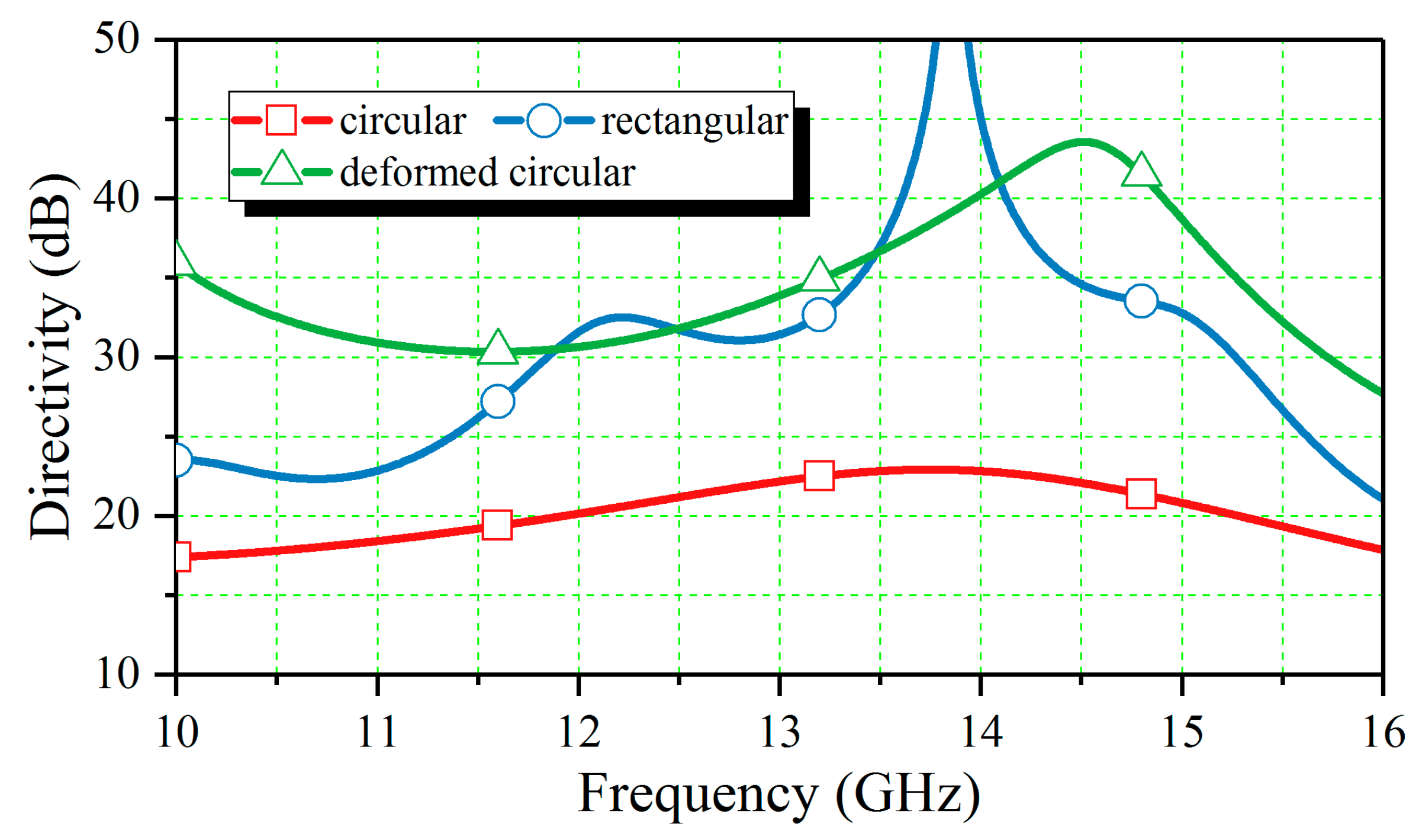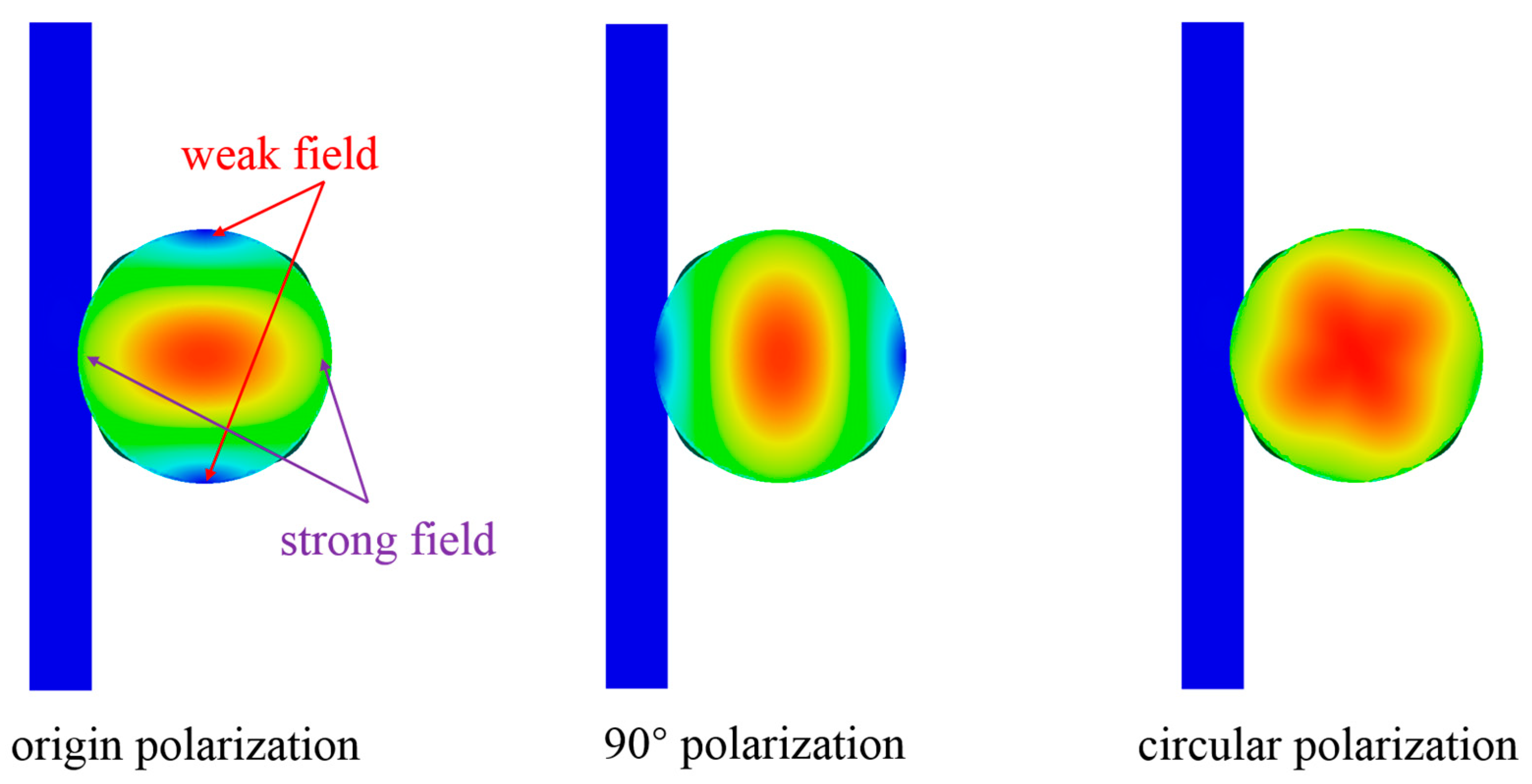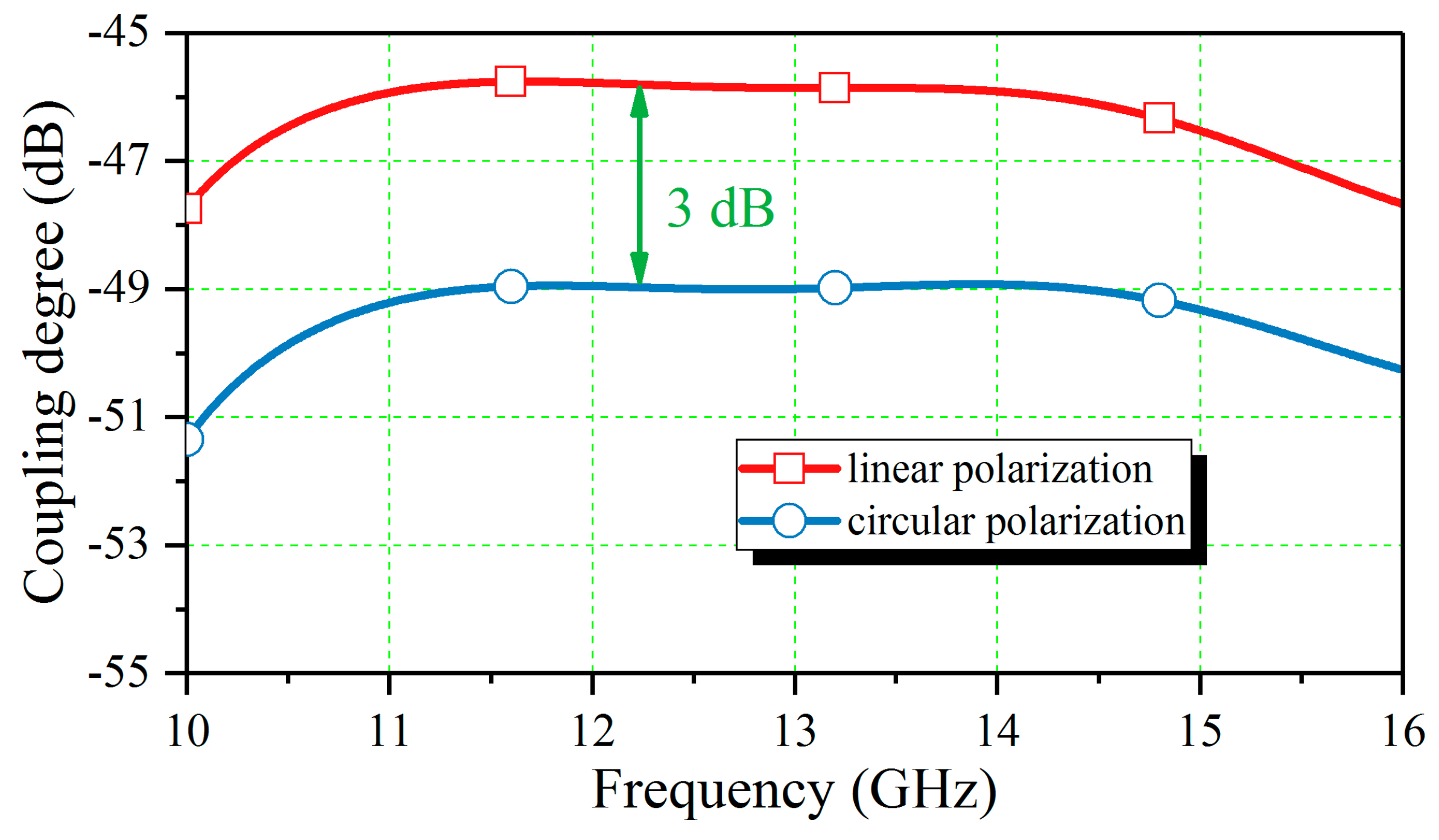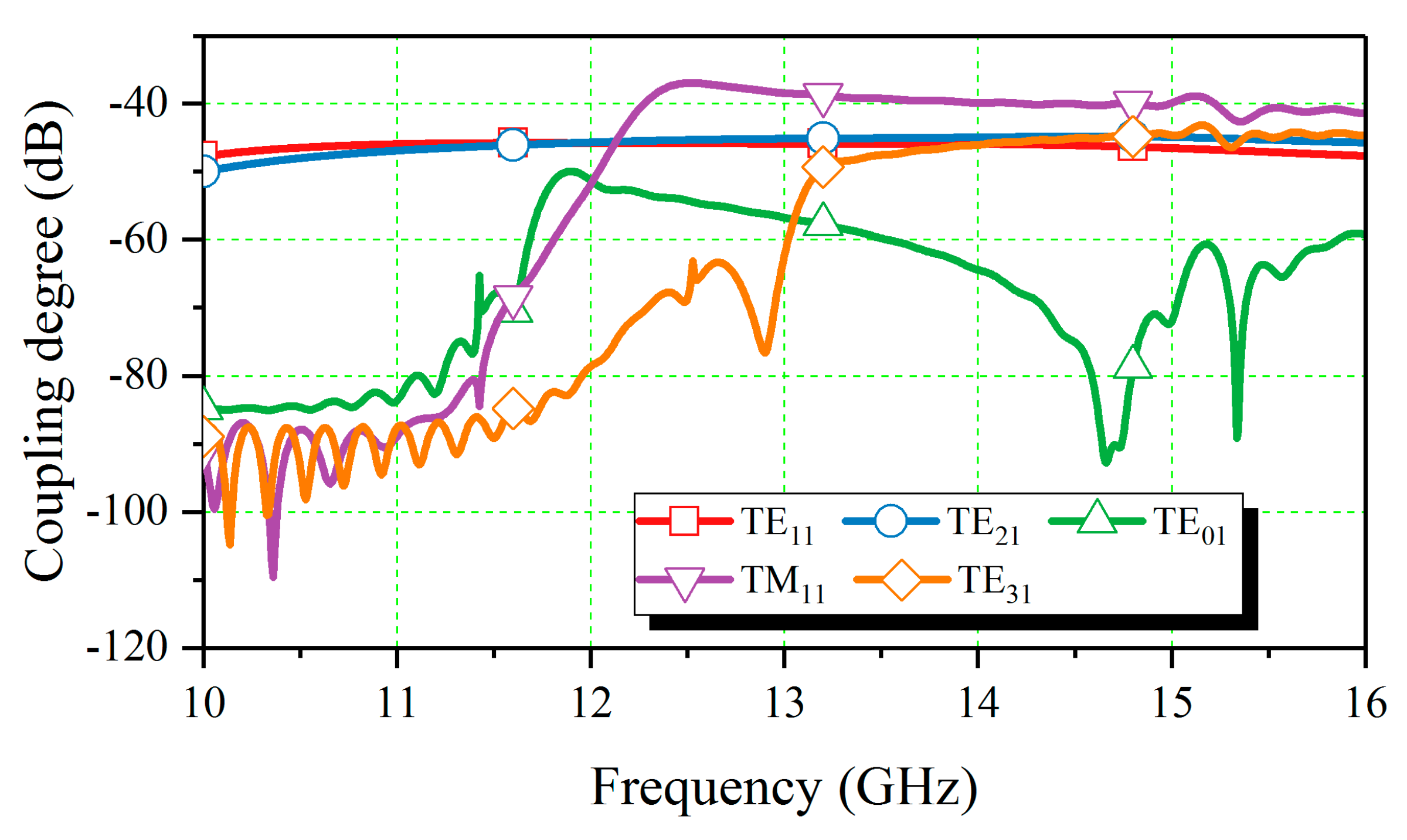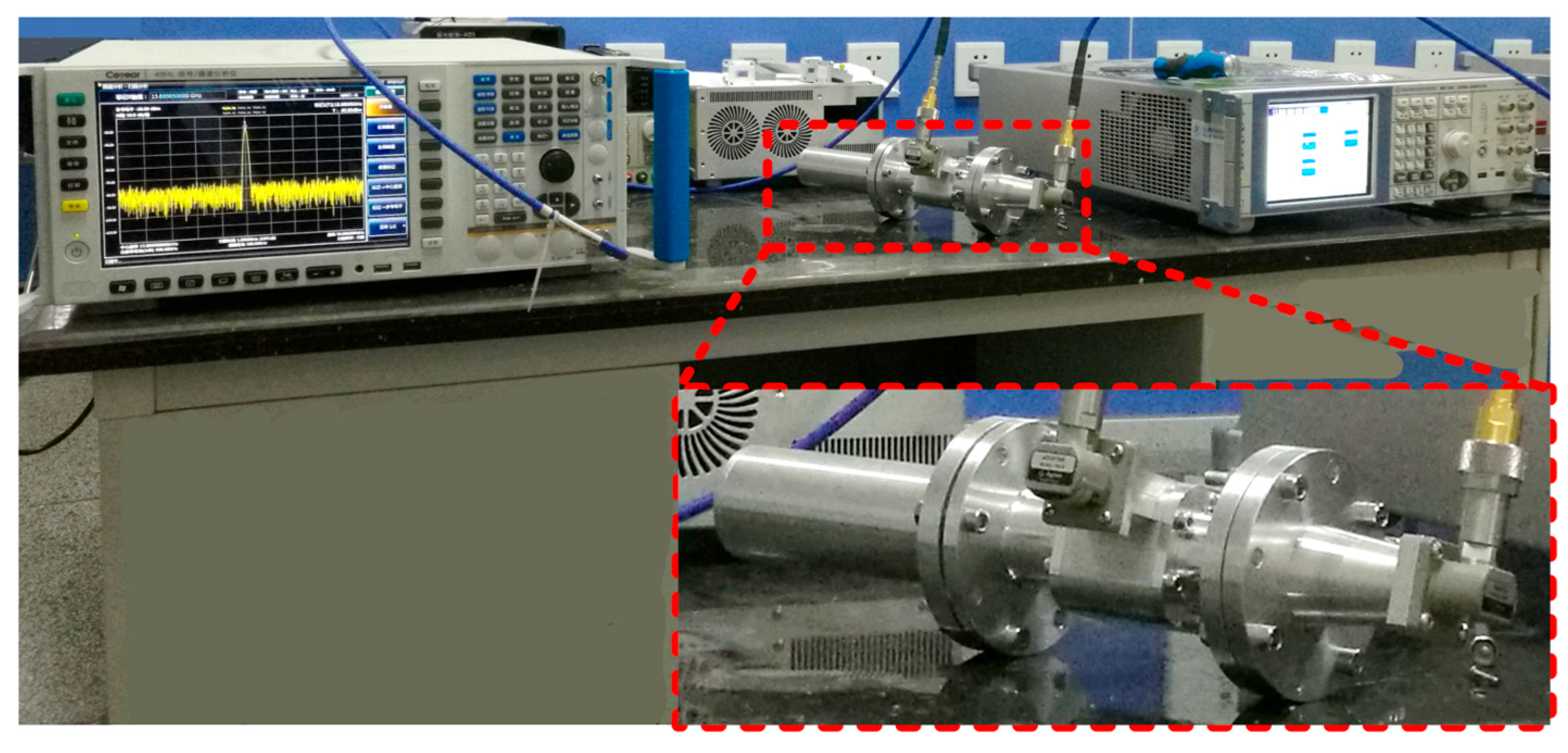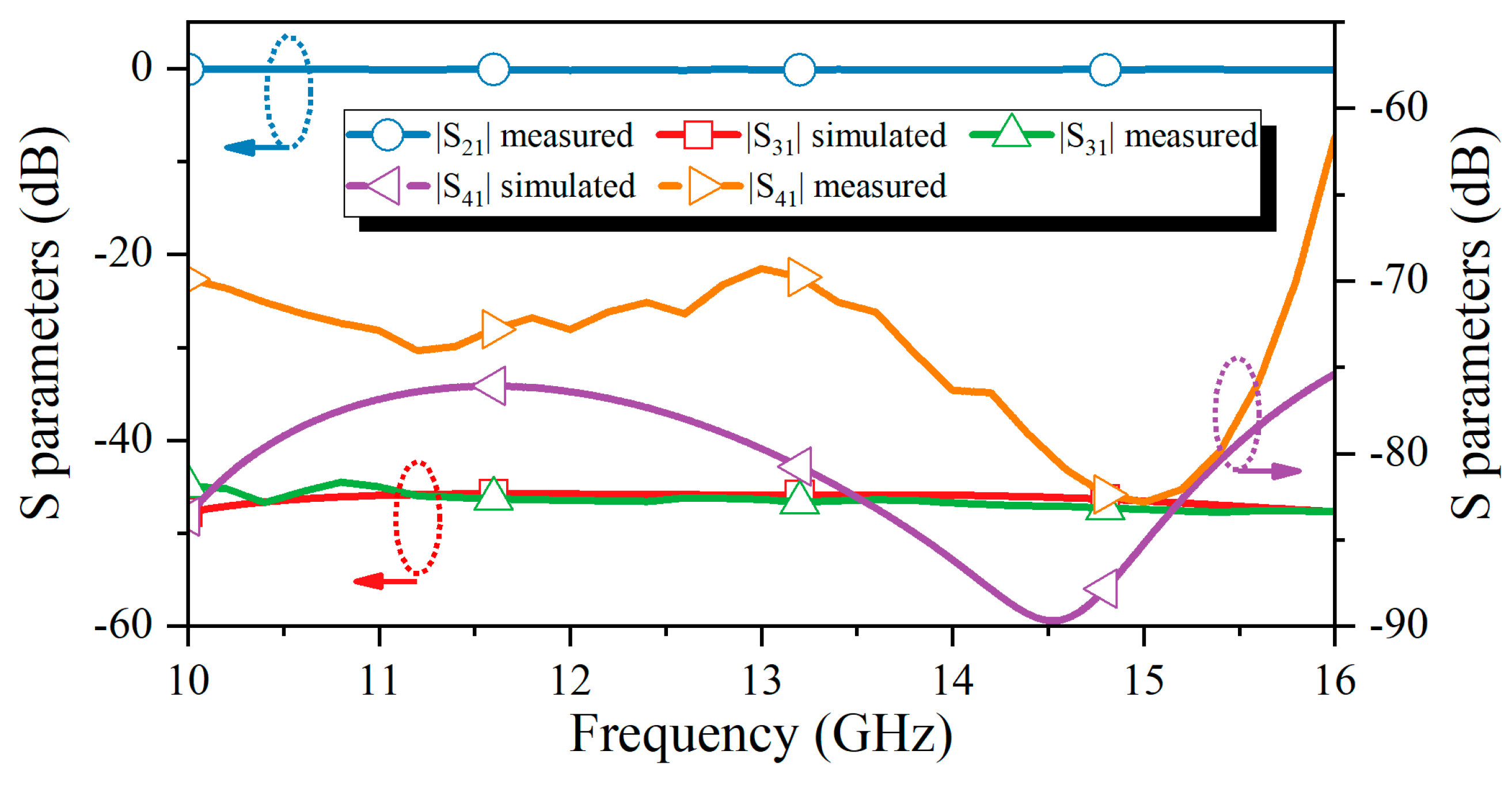2. Design and Analysis
The overview of the proposed directional coupler configuration is shown in
Figure 1. The coupler consists of a circular main waveguide and a rectangular branch waveguide, which cross at 90-degree angles. The high-power microwave is transmitted in the main waveguide, input from port 1 and output through port 2. A small portion of the microwave energy passes through the coupling slot into the branch waveguide in a certain ratio and can then be obtained at port 3, namely the coupling port. The isolation port (port 4) has almost no microwave power in contrast to port 3, and their difference can thus create a high directivity. The input/output radii of the main waveguide are R = 16 mm for convenient connection with oversized circular waveguide transmission lines. The main waveguide contains a significantly oversized DCW, originating from a circular waveguide with four symmetrical perturbations in the radial direction. The outline of the DCW is defined by analytical equations as follows:
where
a0 is the average radius of DCW, which should be close to the radius of the circular waveguide, and a
1 determines the perturbation degree dependently related to
a0. The values of
a0 and
a1 ought to be selected appropriately to adjust the outline of DCW to guarantee power capacity. Moreover, they also need to be fine-tuned in conjunction with the optimization results of the coupled structure to increase the directivity and bandwidth. Additionally, in this design,
a0 is chosen to be 15.5 mm, and
a1 is 2.2 mm. The main waveguide and the branch waveguide are connected by a group of azimuthal slots whose length, width, and location are well optimized by PSO. A pair of linear transitions between DCW and circular waveguide is placed to realize the TE
11 mode transition in high efficiency.
As shown in
Figure 2, the introduction of the DCW changes the shape of the original circular main waveguide, allowing the main waveguide to be slotted along the azimuthal direction. In this case, electric coupling can be achieved in circular waveguide couplers. Additionally, with the help of the DCW, the coupler performs well in polarization discrimination. As indicated in
Figure 2b, the electric field distribution of the circular TE
11 mode in the DCW focuses only on the opposite sides (X side). The field focus brings two advantages. On the one hand, the focus strengthens the field at the waveguide’s wall, which increases the upper limit of the coupling degree. The adjustment range of the coupling degree is thus enlarged, which helps to obtain the desired coupling degree during the design. On the other hand, the field focus makes it applicable in circularly polarized transmission line. When the polarization direction of the TE
11 mode is parallel to the slots’ sides (along the Y side), the mode field is weak, having little impact on the coupling degree. On the contrary, when the TE
11 mode is vertical to the slots’ sides (along the X side), the field is much stronger, which is the most significant factor affecting the coupling. Therefore, the considerable difference of field on the waveguide wall makes the coupler suitable for circular polarization application, and the power measured through the coupler is half of the actual power. Moreover, since the DCW is highly similar to the circular waveguide, the transition between them is simple and efficient. Except for the intuitive electric field changes, the introduction of the DCW also contributes to performance advancement, which will be illustrated in the following part.
The branch waveguide consists of a nonstandard rectangular waveguide along with its linear transition to a standard waveguide. A nonstandard rectangular waveguide (20 mm × 7.9 mm), rather than the standard WR62 (15.8 mm × 7.9 mm), is used to match the DCW’s propagation constant
β, thereby extending the frequency band for high directivity. In order to enable a convenient connection to the standard transmission line, transitions to WR62 are placed at both ends of the branch waveguide. Relevant configuration parameters are shown in
Figure 1.
The main and branch waveguides are connected through four rectangular slots. As shown in
Figure 1, the slots are arranged in a centrosymmetric manner at the center of the DCW to achieve high directivity. Through the slots, signals transmitted in the main waveguide excite equivalent electric dipoles, which allow the circular TE
11 mode in the main waveguide to couple into the rectangular TE
10 mode in a controlled proportion. By optimizing the slot geometry, these electric dipoles can contribute to high directivity and a stable coupling degree over a broad bandwidth. Here, the rectangular slots, rather than the commonly crossed apertures that are generally used in the Moreno coupler, are employed to improve polarization discrimination. Unlike the crossed apertures, the rectangular slots can suppress the TE
11 mode, whose polarization aligns parallel to the slots, preventing excitation of the dipoles. Note that all slots are chamfered to reduce effects caused by structural irregularities, such as reflection, reducing machining requirements.
The simulation results of the directional coupler and its electric field distribution pattern at 13 GHz are depicted in
Figure 3. The high directivity is observed, as the signal in the branch waveguide exits only through Port 3, while Port 4 shows minimal field distribution. The performance of the coupler is shown in
Figure 3, where the transmission efficiency of the TE
11 mode in the main waveguide is greater than −0.05 dB, and the port reflection is below −40 dB in the frequency range of 10 GHz to 16 GHz. The transmission and reflection results indicate that the high-power millimeter wave suffers little loss in the proposed directional coupler. Moreover, the coupling degree is stable around −46.5 dB, varying from −45.7 dB to −47.5 dB, while the isolation degree is less than −75 dB. In this case, high directivity greater than 28 dB is achieved from 10 GHz to 16 GHz.
The power capacity of the waveguide directional coupler is investigated as well to guarantee its feasibility in high-power systems. Since passive devices in high-power systems usually have a temperature rise during operation, which also affects the breakdown threshold, the breakdown thresholds of devices in the temperature range of 293 K to 393 K are analyzed. Here, the background gas is set as dry air, and the air pressure is set to atmospheric pressure. The power capacity results are shown in
Figure 4. It is clear that the power capacity of the directional coupler is over 2.03 MW in the temperature range of 293 K to 393 K. Considering that the output power of a gyro-TWT is only a few hundred kilowatts at most, the proposed directional coupler is able to work in the gyro-TWT system stably.
In order to explain the merit of the DCW, two extra directional couplers based on normal waveguide structures are designed, of which the DCW is replaced by a circular waveguide and a square waveguide, respectively, as shown in
Figure 5. Other parameters of these directional couplers, including the branch waveguide and the size or distribution of coupling holes, are kept unchanged. The coupling degree, the isolation degree, and the directivity of these couplers are displayed in
Figure 6,
Figure 7, and
Figure 8, respectively. Here, the transmission efficiency and the port reflection are not exhibited, as these couplers are all low in propagating losses due to their highly oversized main waveguides. As shown in
Figure 6, the coupler based on a circular waveguide has an obviously small coupling degree, of which the highest value is only −52 dB. The peak coupling degree of the circular coupler is much smaller than that of the DCW or square waveguide coupler, which is around −46.5 dB, as the circular waveguide cannot focus the electric field into the coupling area. The low coupling degree requires a more sensitive power measurement device, increasing the realization difficulty of power monitoring. Therefore, the circular waveguide is not suitable for designing the cross-type directional coupler.
As for the square waveguide coupler, its coupling degree is highly similar to the DCW coupler, according to
Figure 7. However, it can be concluded from
Figure 7 that the isolation degree stability of the square waveguide coupler is inferior to the DCW coupler. In the frequency range of 10 GHz to 16 GHz, the average isolation degree of the square waveguide coupler is −75.6 dB, which is more than 3 dB higher than the DCW coupler, whose average isolation degree is −78.8 dB. As a result, the DCW coupler has a better directivity than the square waveguide, as shown in
Figure 8. The average directivity of the DCW is 32 dB, while that of the square waveguide is only 28.8 dB. Obviously, using the DCW can help increase the directivity of a directional coupler.
Due to the field focusing characteristic of the DCW, the side wall field of the working TE
11 mode concentrates along the direction parallel to the coupling holes, while the side wall field in the transverse direction, which is perpendicular to the coupling holes, is weak, as shown in
Figure 9. The selectivity characteristic of the field direction suggests that the coupler has a strong capability for polarization discrimination, which makes it potentially applicable in circularly polarized transmission systems. To demonstrate its polarization discrimination ability, the directional coupler is inputted by two different linear polarization TE
11 modes, of which the polarization angular difference is π/2, and the result is shown in
Figure 10. The original polarization is defined when the polarization direction of TE
11 mode is perpendicular to the rectangular slots, distinguished from the other polarization mode, which is parallel to the slots (referred to as 90° polarization). It is apparently shown in
Figure 5 that polarization discrimination is achieved since the coupling degree of the origin polarization is at least 13 dB larger than the 90° polarization, whose coupling degree is around −61 dB. Due to the polarization discrimination ability, the proposed directional coupler is able to work in a circularly polarized system. As shown in
Figure 11, the coupling degree results of the directional coupler, which is inputted by a linearly polarized TE
11 mode and a circularly polarized TE
11 mode, are exhibited. Clearly, the results lines are mostly parallel. The coupling degree of the linear polarization is around 3 dB higher than the circular polarization in the frequency range of 10 GHz to 16 GHz, and the maximum fluctuation is only 0.5 dB, which occurs at 16 GHz. Therefore, the capability of the coupler to work in a circular polarization system is verified, and power monitored through the coupler can be regarded as half of the real one.
For a component working in an oversized waveguide transmission line, the effect of parasitic modes on the directional coupler should be investigated. In a high-power transmission line, shape transformation or discontinuity, such as bends or connection flanges, can result in the generation of parasitic mode [
15,
16,
17,
18]. Moreover, the output of the gyro-TWT itself may contain parasitic modes as well. Therefore, estimating the directional coupler’s performance under parasitic mode input conditions is necessary. In this part, several typical parasitic modes in the oversized circular waveguide transmission lines operating in TE
11 mode, including the TE
21, TE
31, TM
11, and TE
01 modes, are selected for investigation. In
Figure 12, the coupling degree of the proposed directional coupler with different input modes is displayed. It can be clearly seen that the results of TE
21 mode are mostly identical to those of TE
11 mode. The TM
11 mode is cut-off under 12 GHz, yet the coupling degree of it increases rapidly around 12 GHz and exceeds that of the TE
11 mode in the frequency range of 12.3 GHz to 16 GHz. The TE
01 mode is also cut off under 12 GHz. However, its coupling degree only reaches a peak value of −50 dB at 11.9 GHz and then decreases rapidly. The TE
31 becomes a propagating mode over 13 GHz, and its coupling degree between 13 GHz and 16 GHz is also similar to the TE
11 mode. In addition to the coupling degree, the isolation degree of the coupler with parasitic mode inputs is also analyzed, as shown in
Figure 13. Clearly, the isolation degree results of the parasitic modes are much more than that of the operating TE
11 mode. For example, though similar in coupling degree, the TE
21 mode’s isolation degree is around −60 dB, which is over 10 dB higher than the TE
11 mode’s results, which is around −80 dB. The TM
11 mode has the highest isolation degree, ranging from −50 dB to −40 dB, which is considerably close to its coupling value.
To illustrate the parasitic modes’ influence on the directional coupler further, the directivity of the coupler input by the operating mode and the parasitic modes is investigated, as shown in
Figure 14. It can be concluded that the operating TE
11 mode has the highest directivity. The directivity results of the parasitic modes are much lower than that of the TE11 mode, with values mostly under 20 dB. For an intuitive demonstration of the parasitic modes’ effects on the directivity, the electric fields in the branch waveguide when the coupler is inputted by these concerned modes are exhibited in
Figure 15. It can be observed that only the TE
11 mode can converge the power unidirectionally to the coupling port. The TE
01 mode has no clear field direction, while the other parasitic modes all have negligible power flow toward the isolation port. Therefore, the parasitic modes have a strong impact on the directivity performance of the directional coupler. They are able to affect the coupling degree to different extents, thus interfering with the accuracy of power monitoring. Meanwhile, due to the deterioration of directivity, the power of parasitic modes can be transmitted to the isolation port, which poses a significant challenge to load stability in high-power applications. Hence, extra consideration should be taken to protect the isolation end. In conclusion, according to the above analysis, the proposed directional coupler is able to monitor the whole power of the transmission line even in the case of parasitic mode interference since its coupling degrees for both the operating mode and the parasitic ones are similar.
For comparison purposes, the proposed directional coupler is compared to other designs in terms of directivity, bandwidth, and size, as shown in
Table 1. Note that since some of the designs are not designed for high-power applications and are not developed based on oversized waveguides, there is no need to compare their dimensions with this design. According to the comparison, the proposed directional coupler is high in directivity, and the corresponding bandwidth is also broader than most of the designs. Especially compared with the high-power directional coupler in [
5], the size of the proposed directional coupler is reduced on a large scale, indicating the compact feature of this design.
